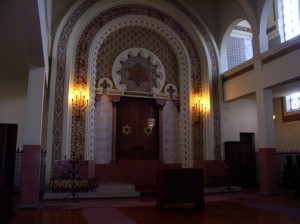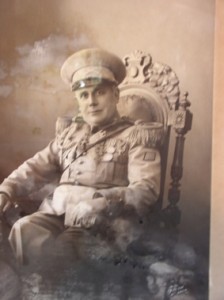
View from Inside the main sanctuary in Porto
The Porto community was reestablished due to the emergence of Captain Basto Baros n the 192’s when he announced that he was a annus. He was a charismatic leader that went to Morocco to official convert and have a brit milah. He then toured the county exhorting his comrades to announced their Judaism. He established minyanim, a school, a newspaper in portugeze called “halapid”. He raised money from the Spanish Portugeze community in London and erected the imposing large shul in Porto. Today, a museum of his Judaica collection and library exists there. Iti s quite impressive.

School room or yeshiva in Porto of Basto Barros

Captain Barros Basto
The Marquês de Pombal broke the power of the Inquisition in the late eighteenth century, though it wasn’t abolished until 1821. In the nineteenth century a new community began to take form, as Sefardim from Gibraltar and Morocco—many undoubtedly with roots in Portugal—arrived in Lisbon and the Algarve. The first post-Inquisition synagogue was built in Lisbon in 1902. In the two decades before World War II small numbers of Ashkenazim arrived from Russia, Germany and Poland.
During the war, thousands of Jews moved through neutral Portugal. Before it adopted a more liberal visa policy, Portuguese consulates routinely denied visas to refugees—except in Bordeaux, where the consul, Aristedes de Sousa Mendes, defied orders and issued 10,000 visas before being ordered back to Lisbon and fired. He was ultimately recognized as a Righteous Gentile by Yad Vashem, the Holocaust Memorial in Jerusalem.
Captain Basto Barros
From his loving grandfather he learned the secret of his family’s Jewish origin. This revelation led him to try to force his way into the mainstream of Judaism, despite the opposition of the Jewish community in his country. His ancestors were “New Christians”, descendants of those Jews who had been forcibly converted to Christianity in 1497. But they were not necessarily crypto-Jews or marranos . The moment he returned to Oporto and began to form a Jewish community with the few Ashkenazi residents of the town, he was surprised at the number of his compatriots who appeared before him and admitted having practiced Jewish rites in secret. Fascinated with these revelations, Barros Basto travelled extensively through the villages and towns of northern Portugal, in order to get acquainted with these crypto-Jews, and to learn more about their religious practices and their way of life. He made no attempt to change such beliefs and practices. What he did do was devote himself to stripping the secrecy from their way of life, to convincing them that the Republican revolution – in which he had taken part – had opened a new era of freedom for the still practicing descendants of the Jewish victims of forced conversion. Unfortunately, he did not know then just how shortlived this freedom was to be. Barros Basto’s “Work of Redemption” was intended to lead the marranos into practicing their own version of the Jewish religion openly and without fear, and to help them, by all available means, to recover and bring up to date all the information about Judaism which they had lost during the preceding four centuries.
Community:
There are about 1,000 Jews in Portugal, of whom 600 live in the Lisbon area, 180 in Belmonte and 120 within two hours of Porto. Those of Jewish descent who are pursuing their roots in one way or another would add modestly to the numbers. In central Lisbon, some Jews live near the main synagogue, Shaare Tikva, at Rua Alexandre Herculano 59 (telephone, 213-858-604), and there is another concentration of sorts along la linha, the rail line that goes to the seaside communities of Estoril and Cascais. There is also a small Ashkenazic synagogue, Ohel Jacob, at Rua Elias Garcia 110 (217-971-033), where about one third of the regular congregants are anousim—descendants of crypto-Jews seeking their way back to Judaism.